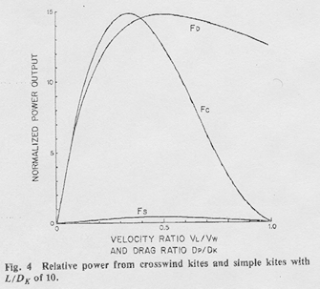Has it really been 2 months? Sorry for the lack of updates, I have been desperately trying to bring my work together for my Dphil thesis which is due to be submitted in 53 days exactly and I'm still, hmm about 25k words and about 10 flight tests short!
Here is some of the ground gen/ flygen comparison brutally culled from my post on the awe list and from Loyd's wonderful paper.
Ok, some pros and cons. This is assuming that for a flygen you would have a hard wing and for a groundgen a soft wing. Uwe at TU Delft pointed out quite correctly that you can have a hard wing groundgen like that at Ampyx that will have some of the advantages (and disadvantages!) of both approaches.
| Soft | Hard |
| Harder to get high L/d | Easier to get high L/d |
| Lighter | Heavier - inertial loss? |
| Less prone to weight penalties on scaleup | More prone to weight penalties on scaleup |
| Cheap | Expensive |
| Subject to wear, esp when fluttering | Excellent wear characteristics |
| Under-actuated | Excellent control authority |
| Difficult and comp expensive to model- Multibody approach? | Can be modeled through conventional techniques, i.e.Neuton/Euler or Lagrangian in real time |
| Pack down small | Don't pack down |
| Could deform to match conditions | Must operate in all conditions |
| Can do ground gen | Must run power down cable |
| Severe cable wear from repetetive bending - if doing groundgen | Cable bending frequency is low - if doing flygen |
After that, here are some gems from Loyd:
Basically this is saying that the power scales linearly with air density but with the cube of the apparent windspeed. Translation: Going fast is dispropotionately rewarded, when going high air will be thinner but this should be more than cancelled out by faster wind.
Next....Speed, and hence apparent wind speed is going to be affected by the lift/drag (glide) ratio of the wing, less drag meaning more speed. According to Loyds analysis this is another exponential effect - check it out here for the drag(flygen) mode, where:
This graph shows the exponential scaling showing how important efficient wings are. It looks linear but the scales are logarithmic ok!
This next graph shows that the peak power of the lift(groundgen,Fc) and drag(flygen,Fd) modes are pretty much the same. Groundgen reelspeed wants to be about 1/3 of windspeed, and there is a broad peak for the flygens in terms of the ammount of drag you put on the wing, which gives a fair bit of operational leeway.
Now, Loyd does miss some things out for that comparison graph: tether drag: assuming that you have an unfaired ( a normal) tether, it will begin to dominate the drag of the system as your l/d on the wing gets higher and higher, so you won't see anything like the advantage shown by the graph.
Also Loyd assumed weightless wings.... why does this matter? Because during steering you are pulling the wing away from the direction it's is going, you will be using some of the energy from the wind for fighting the wings inertia. The heavier the wing the greater the loss.
Ok there ares a load of other things that could be incorporated to a model but that's enough for one day. So.. the conclusion is..... There is no clear winner, each approach has advantages and disadvantages, the 'best' solution won't neccesarily win the market, it will be a balance based on capital cost, performance, durability, safety, public acceptance, and more. In short, there's no free lunch.







